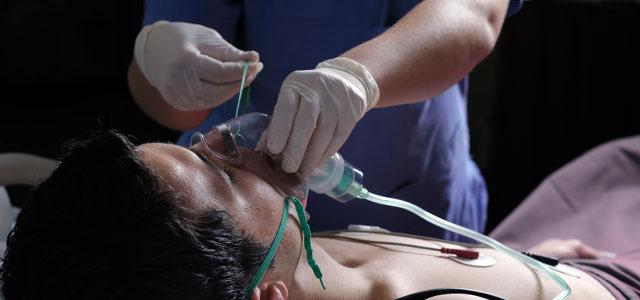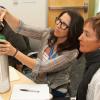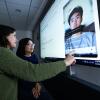
Seminal Program Has Changed, Improved Acute Care in Northern California
To celebrate the 150th birthday of UC San Francisco and the role that the School of Nursing has played in this unique health sciences institution, Science of Caring is running a series of stories that focus on important, often seminal contributions that the School has made to health care delivery, education and research. The acute care nurse practitioner (ACNP) program at the School – which graduated its first pilot group in 1997 – has been a pioneer in placing ACNPs in hospital settings throughout Northern California and, in doing so, improving care in those settings.
Note: This article originally appeared in Science of Caring in September 2013.
Twenty years ago, Kathleen Puntillo was among those who saw the changes coming: the reduction in resident work hours; a sicker, older inpatient population; acute and critical care settings scrambling to staff their units.
Puntillo had read about hospitals in other parts of the country experimenting with specially trained nurse practitioners (NPs) on critical care teams, and though she’d only joined the faculty at UC San Francisco School of Nursing a few weeks earlier, at her first faculty retreat she proposed creating an acute care nurse practitioner (ACNP) program at the School. This despite the fact that to her knowledge, in Northern California hospitals, there were zero – count them, zero – ACNPs prepared for critical care settings.
“But I knew in other settings, NPs had been successful bringing nursing to the traditional medical realm,” says Puntillo. “I had had years in critical care and could see there would be a role.”
She asked Jill Howie Esquivel, at the time a critical care nurse specialist and nurse practitioner at UCSF Medical Center, to help establish the program. They and their colleagues focused on three clinical settings – intensive care, trauma and cardiopulmonary care – and created a curriculum that was distinct from the School’s highly respected clinical nurse specialist (CNS) track in critical care. While they worked to secure a Health Resources and Services Administration (HRSA) grant to support a master’s degree program, they got a small post-master’s group up and running.
“In 1997, we graduated a pilot group of four ACNPs,” says Howie Esquivel. “They were hand-selected, because we knew there were no job openings and they would have to be strong personalities and confident in their clinical skills.… It was a real challenge for all of us to learn how to market this.” Faculty members developed cold call letters and stressed interviewing skills. They created fact sheets to leave behind with administrators after interviews.
“It was an amazing process to watch and be a part of,” says Howie Esquivel.
Fifteen years later, the 216 graduates had changed the nature of acute care in hospitals throughout Central and Northern California. Alumni play prominent roles in almost all of the region’s best hospitals, write academic papers, participate in research and pursue both PhD and DNP degrees. In July, graduates from the program were among those at San Francisco General Hospital who treated injured passengers from Asiana Airlines Flight 214. Initial studies indicate that these NPs have not only maintained but even, at times, improved quality in acute care units.
But winning over resistant or skeptical faculty colleagues, creating relevant curriculum and doing the hard, sensitive work of integrating themselves in clinical settings was a challenge. In some places, it remains one. Meeting this challenge has taken a determined faculty, a clear need and the support of farsighted nursing and physician colleagues to enable the program and the role to evolve and thrive.
At San Francisco General Hospital
“Bob Mackersie [director of the trauma service at SFGH] was the first physician I went to,” says Puntillo today. “He was very nice but skeptical and asked what the NPs would do. I emphasized…that they wouldn’t rotate like residents and, so, would provide continuous care.… He ended up writing a letter in support of our HRSA grant.”
“We had begun to see the value in developing a service with a little more clinical consistency,” says Mackersie. “Also, the trauma service has needs that are not the primary focus of surgical trainees. They operate – and they’re great at taking care of the critically ill – but when you get into coordinating care, discharge planning, talking to patients, that’s not their primary focus.”
In 1999, a team of people championing the project – including Mackersie, ACNP Mark Hawk (who was working in the SFGH emergency room and would become a faculty member and one of the original NPs in the trauma unit) and SFGH CEO Gene Marie O’Connell (an RN with a master’s degree from UCSF School of Nursing) – identified potential stumbling blocks and began addressing them.
Two years later, Hawk and fellow NPs Gail Norman and Amanda Brill reported to work in the trauma unit – and quickly found that some stumbling blocks remained.
“House staff didn’t understand [NP] scope of practice and they were often ignored,” admits Mackersie. “Maybe that’s the natural growing pains of any new service, but after a few years, people got used to seeing them around and their scope of practice began expanding.”
Today, the NPs are the equivalent of second- or third-year residents. Their numbers have grown to 13 in trauma/general surgery, with another 17 in positions throughout SFGH. They admit and manage patients, coordinate care with other clinicians, do procedures, precept NP students and train first-year residents. A couple of NPs are now trained and credentialed as first assistants in the operating room.
“They are an invaluable and complementary extension of our practice,” says Mackersie. They are so skilled at presenting, he adds, that senior residents tend to prefer rounds with the NPs, because they know the patients so well and are so adept at providing capsule summaries.
“And the interns love them,” says Mackersie. “The NPs have more time and more patience than senior residents.… If [the NPs] disappeared, we could not run this service.”
In UCSF Medical Center ICUs
In 2004, intensivist Michael Gropper – who directs the intensive care units for UCSF Medical Center – was wrestling not only with the changes in resident work hours, but also with the opening of a fifth ICU.
“In the past, we would have added more residents, but that was no longer an option,” he says. After speaking with colleagues across the country, he was convinced NPs were the best alternative and helped sell the Medical Center on the idea.
“The first few years, there wasn’t really a blueprint as to how we’d function,” says NP supervisor Geoff Latham, one of the original NPs in the UCSF ICU and co-author of a study on the evolution of the position at UCSF Medical Center. “People hadn’t seen NPs in this role before, and we were fresh graduates. We’d had excellent training and critical care bedside nursing experience, but we were still inexperienced as NPs.”
Over the next few years, the ICUs served as a training ground for Latham and his colleagues, a clinical placement for NP students from the UCSF program – and a means to identify the best of those students. As the NPs demonstrated their professionalism, scope of practice became more clearly defined and senior leadership voiced its support, the tension over the NPs’ role eased.
This was true even for the sensitive issue of the NPs’ impact on resident training. “Residents want to do procedures and that’s understandable,” says Gropper. “But we’ve made clear that NPs have independent privileges: when they admit a patient, it’s their patient, and our rules are that if it’s your patient, then it’s your procedure.” He says the experienced NPs ease the tension by their willingness to be flexible and teach first-year residents.
“My job is colored by dissatisfaction, and it’s been remarkable how little there has been,” says Gropper. “With more familiarity, there’s been more appreciation for the knowledge the NPs bring.”
Today, the UCSF Committee on Interdisciplinary Practice has approved NPs at the Medical Center to, among other things, write admission and routine orders, respond to code blue activations, assist with rapid response and conduct procedures, including procedural sedation and endotracheal intubations. While their home base is the medical/surgical ICU, they are also in the cardiac ICU and cross-cover the neurological ICU nights and weekends.
“For all of our responsibilities, it’s about working well as part of a team,” says Latham. “UCSF fosters an environment where lines of communication are open.”
The team approach enables the ACNPs to bring unique advantages to the critical care setting. For example, Gropper believes the synergistic training of the residents – who have greater breadth of training – and the NPs, who have more depth of experience in the ICU, has been a boon for quality.
He adds that the NPs’ consistent presence and training are essential for quality improvement and consistency of care – a challenge in the complex ICU environment. He points to the introduction of intensive insulin therapy, which involves a complicated algorithm and a potentially dangerous medication. “The NPs, who are expert in systems, allow us to do this very safely – they’re more experienced with it than anybody.”
Gropper believes what is going on in his ICUs is a clear indication of the future of health care. “It’s a great example of where we’re going with transprofessional training and care,” he says. “The hard part was year one, but now we’ve gone through a whole generation of residents who’ve worked with NPs. This is their understanding of how health care is done.”
At Queen of the Valley Hospital in Napa
After spending 13 years as a nurse in the ICU and in cardiac and cardiothoracic surgery, Vicki Moore entered the UCSF ACNP program in 1999, as part of its third cohort of students. Upon graduation, she became the first NP at Queen of the Valley Medical Center in Napa.
Queen of the Valley is not a teaching hospital, so the concerns there were not about resident work hours, but about the need for a qualified person to do rounds with patients so the facility’s two heart surgeons could meet the demand for more surgeries. A CNS at the hospital knew of the ACNP concept and suggested the heart surgeons contact UCSF. Moore’s experience was an ideal fit.
As in the other settings, the first couple of years were challenging. “I kept feeling like I had to clarify that ACNPs are trained in the medical model but also bring years of nursing experience,” says Moore. “I had to justify my existence and explain the benefits of my role for patient safety and satisfaction, as well as the hospital’s quality outcomes. Once people recognized how beneficial the role was, it was a win-win-win for everybody.”
Today, Moore is the ACNP for cardiothoracic and vascular surgery and has helped define the role for a growing number of ACNPs at Queen of the Valley. The six ACNPs cover cardiology, neurological/spinal surgery, general surgery and trauma services. They follow every patient on their service throughout their continuum of care – and the hospital is considering adding additional roles for ACNPs.
With their wealth of knowledge about each patient and their team-based approach, the ACNPs look at the whole picture to address patient concerns and educate patients and families about inpatient and postdischarge care, and are crucial to specialty consults. “If someone develops an acute kidney injury in the postoperative period and I need renal consultation, I should be able to tell the physician things about the hospital course that they can’t find in the chart,” says Moore, who recently earned her DNP from Rush University in Chicago.
She says the results of the ACNP presence are tangible. “Within my first year, we had substantially decreased postoperative patient length of stay and minimized perioperative complications,” she says. “I’ve been blessed to be able to expand the ACNP role here, and I’m very thankful to my physician champion, the surgeon who took a chance on me. It had a rippling effect.… Once they saw the work we did, the cardiologists, other surgeons and the trauma docs all wanted to be on board.”
The Evolution of a Program
As health care has changed and the role has evolved, ACNP training has had to evolve with it, including ensuring that the NPs are prepared for national certification, says Roxanne Garbez, who directs the program while maintaining a clinical practice as a nurse practitioner in an emergency department in the Central Valley.
According to the California Board of Registered Nursing, certified nurse practitioners must serve at least one of six populations. The ACNP program at UCSF targets the acute care needs of adults and older adults, and graduates must meet all the requirements of any NP program, which means demonstrating an expertise in internal medicine, while also showing a firm grasp on acute care.
In addition, to enter the program an applicant must have experience as a bedside nurse in an acute care clinical setting. “Our students are placed in critical care settings where experience is necessary, especially when decisions must be made quickly,” says Garbez. “If you don’t have the background knowledge and skills, you can’t make the transition from a task-driven role to a leadership role.”
Once a nurse has the proper experience and training as an ACNP, they typically can bring their baseline evaluation and management skills to multiple inpatient settings. They learn the specific procedural and clinical responsibilities in simulation labs, clinical rotations and, ultimately, on-the-job proctoring. In clinical rotations, says Garbez, about 75 percent of preceptors are themselves graduates of the program.
“They tend to be rigorous and know what the students need,” she says.
In addition, says Garbez, affiliation with a world-renowned teaching hospital offers students a unique experience. “The patient population is complex and incredibly interesting – and we are very fortunate to have these resources available to students.”
The Future
As the program and the role evolve, faculty and graduates continue to look ahead to the next generation of changes.
“UCSF is a big university and medical center, so patients are always interesting and there are other things to focus on, like research and getting involved in committees and policy development,” says Latham. “The future of how patients are cared for will largely be protocol driven – and developing things like new sepsis protocols goes beyond daily clinical care.”
He does believe, however, that a changing patient population and ever more sophisticated care might necessitate changes in training. NP fellowships might become essential. “Clinical placements are not equivalent to residencies, and someone fresh out of school is not ready for this,” he says. “A fellowship could give them the confidence to do what’s required in critical care.”
Moore says another avenue for growth is the current emphasis on transitions of care. “It might be time for hospitals to align with interdisciplinary services that include NPs, who can see patients in the home setting and reduce readmission rates.”
“In critical care practice, we are looking at post-intensive care unit syndrome,” adds Puntillo. “Both physically and psychologically, there is a cost to having been in an ICU [as a patient], and I think ACNPs are in a prime position to participate and lead some of this research.”
Yet even as she and her colleagues look ahead, Puntillo is both stunned by and proud of the achievements of the program. “At first, we would go to these annual conferences simply to learn from others.… Today, we continue to learn, but other people also are learning from us,” she says. “We’ve had our growing pains, but we’ve been very successful.”



